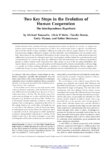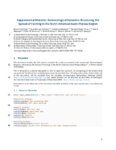|
|
Creator | Title | Description | Subject | Date |
| 101 |
 |
Hawkes, Kristen | Some current ideas about the evolution of the human life history | Human life history is characterised by a long juvenile period (weaning to reproductive maturity), and a long post-reproductive lifespan in females. How do we explain the differences between our nearest relatives, the great apes, and ourselves? This chapter summarises some recent attempts to use l... | Human life history; Fertility; Apes; Juvenile period | 1999 |
| 102 |
 |
O'Rourke, Dennis H. | South from Alaska: a pilot aDNA study of genetic history on the Alaska Peninsula and the Eastern Aleutians | Abstract The Aleutian Islands were colonized, perhaps several times, from the Alaskan mainland. Earlier work documented transitions in the relative frequencies of mtDNA haplogroups over time, but little is known about potential source populations for prehistoric Aleut migrants. As part of a pilot i... | | 2010 |
| 103 |
 |
O'Rourke, Dennis H. | Spatial and temporal stability of mtDNA haplogroup frequencies in native North America | Mitochondrial DNA lineage frequencies in prehistoric Aleut, eastern Utah Fremont, Southwestern Anasazi, Pyramid Lake, and Stillwater Marsh skeletal samples from northwest Nevada and the Oneota of western Illinois are compared with those in 41 contemporary aboriginal populations of North America. T... | Mitochondrial DNA; Lineage variation; Haplogroup assignment | 2000 |
| 104 |
 |
Hawkes, Kristen | Stag hunts or rearing environments? | Tomasello et al. have made the case that shared intentionality distinguishes humans from our nearest living relatives. What accounts for the difference? The answer they offer is Stag Hunt choices faced by ancestral foragers. Noting problems with that answer, I urge attention to a promising alternati... | | 2012-01-01 |
| 105 |
 |
Codding, Brian F. | Supplementary Materials: Socioecological dynamics structuring the spread of farming in the North American Basin-Plateau Region | This document includes the code used to complete the analysis presented in the manuscript "Socioecological Dynamics Structuring the Spread of Farming in the North American Basin-Plateau Region" in Environmental 15 Archaeology. | environmental archaeology | |
| 106 |
 |
Cashdan, Elizabeth A. | Technological change and child behavior among the !Kung | How does change in one part of a social system affect other parts? This is the central question that must be answered in order to understand the process through which culture changes. This paper is about a small piece of the problem. It investigates how changes in subsistence economy affect child be... | Child behavior; Technological change; Foraging groups; Settled groups | 1988 |
| 107 |
 |
Broughton, John | Terminal Pleistocene fish remains from Homestead Cave, Utah, and implications for fish biogeography in the Bonneville Basin | Eleven fish species were identified from Homestead Cave, Utah. The remains, concentrated in the lowest stratum of the deposit, were accumulated by owls between approximately 11,200 and 10,100 14C yr B.P. and likely represent fish associated with the final die-off of the Lake Bonneville fauna. Fou... | Fish assemblage; Quaternary; Lake Bonneville | 2000 |
| 108 |
 |
Cashdan, Elizabeth A. | Territoriality among human foragers: ecological models and an application to four Bushman Groups | Discussions of human territoriality have become more sophisticated in recent years; we see fewer arguments for or against the adaptiveness of territoriality for mankind in general and more attempts to probe the ecological factors that make territoriality adaptive in particular circumstances. | Foraging; Ecological Models; Bushman | 1983-02 |
| 109 |
 |
O'Rourke, Dennis H. | Unangan past and present: the contrasts between observed and inferred histories | Abstract Academic research focusing on the population and culture history of the Aleut (Unangan) people began in the late 19th century and continues to the present. The papers in this special issue of Human Biology summarize the latest results from archaeological, linguistic, genetic, and morphometr... | | 2010 |
| 110 |
 |
Wiessner, Pauline W. | Vines of complexity - egalitarian structures and the institutionalization of inequality among the Enga | The initial stages of the institutionalization of hierarchical social inequalities remain poorly understood. Recent models have added important perspectives to "adaptationist" approaches by centering on the agency of "aggrandizers" who alter egalitarian institutions to suit their own ends through de... | Egalitarian structures; Political evolution; Social d | 2002-04 |
| 111 |
 |
Cashdan, Elizabeth A. | Waist-to hip ratio across cultures: trade-offs between androgen-and estrogen-dependent traits | A gynoid pattern of fat distribution, with small waist and large hips (low waist-to-hip ratio, or WHR) holds significant fitness benefits for women: women with a low WHR of about 0.7 are more fecund, are less prone to chronic disease, and (in most cultures) are considered more attractive. Why, then... | Fertility; Optimum; Fecundity | 2008 |
| 112 |
 |
Cashdan, Elizabeth A. | Waist-to-hip ratio across cultures: trade-offs between androgen- and estrogen-dependent traits | A gynoid pattern of fat distribution, with small waist and large hips (low waist-to-hip ratio, or WHR) holds significant fitness benefits for women: women with a low WHR of about 0.7 are more fecund, are less prone to chronic disease, and (in most cultures) are considered more attractive. Why, then... | Fat distribution; Gynoid pattern; Body types; Waist-to-hip ratio; WHR | 2008 |
| 113 |
 |
Wiessner, Pauline W. | Wealth transmission and inequality among hunter-gatherers | We report quantitative estimates of intergenerational transmission and population-wide inequality for wealth measures in a set of hunter-gatherer populations. Wealth is defined broadly as factors that contribute to individual or household well-being, ranging from embodied forms, such as weight and h... | | 2010-02 |
| 114 |
 |
McElreath, Richard | When natural selection favors imitation of parents | It is commonly assumed that parents are important sources of socially learned behavior and beliefs. However, the empirical evidence that parents are cultural models is ambiguous, and debates continue over their importance. A formal theory that examines the evolution of psychological tendencies to i... | Transmission; Evolution; Culture | 2008 |
| 115 |
 |
Hawkes, Kristen | Why hunter-gatherers work: An ancient version of the problem of public goods | From the abstract: People who hunt and gather for a living share some resources more widely than others. A favored hypothesis to explain the differential sharing is that giving up portions of large, unpredictable resources obligates others to return shares of them later, reducing everyone's variance... | Hunter-gatherer societies; Public goods | 2001-08 |
| 116 |
 |
Cashdan, Elizabeth A. | Why is testosterone associated with divorce in men? | There is evidence that in women high levels of testosterone are associated with more sexual partners and more permissive sexual attitudes. If a similar relationship holds true for men, the higher basal testosterone levels of divorced and unmarried men may be caused by this relationship rather than b... | Marriage; Separation; Hormones; Sexuality | 1998-06 |
















